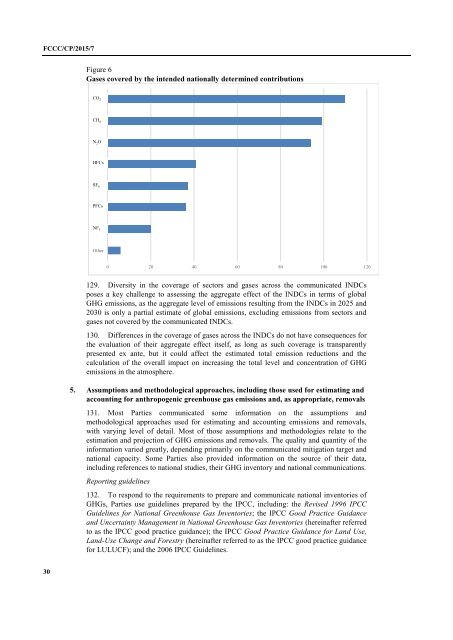FCCC/CP/2015/7
1PYuHQM
1PYuHQM
Create successful ePaper yourself
Turn your PDF publications into a flip-book with our unique Google optimized e-Paper software.
<strong>FCCC</strong>/<strong>CP</strong>/<strong>2015</strong>/7<br />
Figure 6<br />
Gases covered by the intended nationally determined contributions<br />
CO CO2 2<br />
CH CH4 4<br />
NN2O<br />
2 O<br />
HFCs<br />
SFSF6<br />
6<br />
PFCs<br />
NF NF3 3<br />
Other<br />
0 20 40 60 80 100 120<br />
129. Diversity in the coverage of sectors and gases across the communicated INDCs<br />
poses a key challenge to assessing the aggregate effect of the INDCs in terms of global<br />
GHG emissions, as the aggregate level of emissions resulting from the INDCs in 2025 and<br />
2030 is only a partial estimate of global emissions, excluding emissions from sectors and<br />
gases not covered by the communicated INDCs.<br />
130. Differences in the coverage of gases across the INDCs do not have consequences for<br />
the evaluation of their aggregate effect itself, as long as such coverage is transparently<br />
presented ex ante, but it could affect the estimated total emission reductions and the<br />
calculation of the overall impact on increasing the total level and concentration of GHG<br />
emissions in the atmosphere.<br />
5. Assumptions and methodological approaches, including those used for estimating and<br />
accounting for anthropogenic greenhouse gas emissions and, as appropriate, removals<br />
131. Most Parties communicated some information on the assumptions and<br />
methodological approaches used for estimating and accounting emissions and removals,<br />
with varying level of detail. Most of those assumptions and methodologies relate to the<br />
estimation and projection of GHG emissions and removals. The quality and quantity of the<br />
information varied greatly, depending primarily on the communicated mitigation target and<br />
national capacity. Some Parties also provided information on the source of their data,<br />
including references to national studies, their GHG inventory and national communications.<br />
Reporting guidelines<br />
132. To respond to the requirements to prepare and communicate national inventories of<br />
GHGs, Parties use guidelines prepared by the IPCC, including: the Revised 1996 IPCC<br />
Guidelines for National Greenhouse Gas Inventories; the IPCC Good Practice Guidance<br />
and Uncertainty Management in National Greenhouse Gas Inventories (hereinafter referred<br />
to as the IPCC good practice guidance); the IPCC Good Practice Guidance for Land Use,<br />
Land-Use Change and Forestry (hereinafter referred to as the IPCC good practice guidance<br />
for LULUCF); and the 2006 IPCC Guidelines.<br />
30


